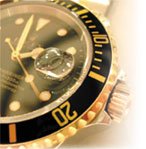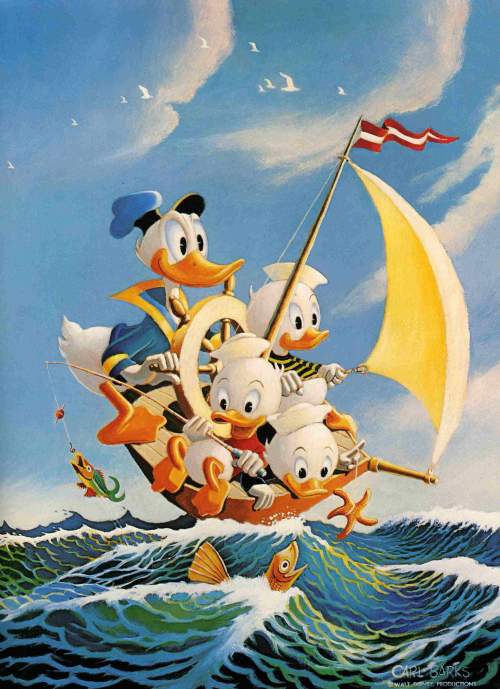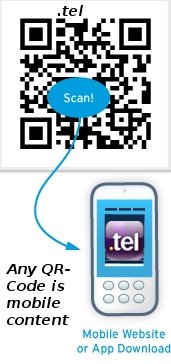You have got a mobile web site (the registry calls ist a page).
Your web site has content: web content.
The content, you could print on paper, each sub-domain, too.
However, that information is stored under your domain name. It is the web content for that name.
You can share your web site, by publishing or sending its web link.
The link fetches the content on the web, so can view it.
An other method of sharing a domain name, is to display a code that can be read, and will so provide the domain name, as well.
Basically, a code shows a piece of text:
An URL
An email address
A phone number
A SMS
A document
Or any other piece of text message.
Code = Text
You get your code for your web site or contact information, if you generate one, by entering the text into a Code Generator, and selecting URL, email, phone, SMS, Text (other), etc.
If you happen to enter an URL, you have the possibility to shorten it by using an URL shortener, such as for example „bit.ly“.
And that is highly recommended, because shortened URLs produce/generate slimmer and smaller codes.
By displaying a Quick Response Code (QR-Code), you are doing nothing else, as displaying an invitation to view your text, web site, or contact information.
People wont know, what they can expect, if you only display a code without any added information about the code. A short and informative description next to the code, will enable the person to either want to scan your code, or to ignore it.
Scanning QR-Codes make sense, because it is easyer to scan a code than a web link, or a whole document/page of text.
You see, here, that you can not only share contact information, or text messages and documents, but als just a web link.
By sharing a web link, you can promote your web site.
Now, if the scanner, which is a smart phone, can als imediatly display the web site, then you can discover and surf the new web site „on the go“.
And so: this is ideal for promoting a mobile web site.
Shortening an URL, and generating a code for that shortened URL, is a no-brainer.
But the other question is: where would you like to display your code?
And how big should it be, so that it is scanable from where the scaner will most likely take it / snap it. But let us leave that question for an other time...
So, you see: your web site can be found offline, by people who are „on the go“. And it can be viewed „on the go“, as well, for example in any public transportation (taxi, tram, bus, train, etc.).
If you want to promote your web site, this way, and you want to show your Dot Tel domain, than you should probably have an other mobile website, as well, and make your .Tel domain your landing page.
It may make sense, to display a .Tel domain, in form of a code, because it can be viewed as business card with contact information, or as a directory (guide or e-commerce, etc.).
Imagine, you only want to do a cheap and quick experiment, and finally do see, that your .Tel domain is ranked high in Google Search. Then you will want to leave it there, and use it as your online landing page, for visitors and customers, and just update the landing page, with your new or updated main mobile friendly web site.
I think, that the Dot Tel domain would be ideal for such an experiment, because it is inexpensive, compared with a complex and heavy web site, and it can be set up online, within an hour, or a few hours.
Dot Tel, is ideal for beginners and non techies. You can get a great sense of achievement, and be successful, that way.
I think it was important to clarify, and to point out, what we are exactly doing with QR-Codes: People are scanning, and then reading the informatin we provide and want to be seen.
Instead of handing out hundrets of flyers, we can just provide one code at one location, for everybody to be seen/discovered.
The whole thinktaking about QR-Codes and mobile marketing, should be within those facts.
I reapeat:
Code = Text.
and
Text can be turned into code.
You have to be lucky, to have someone who sees your code, and who is familiar with scanning QR-Codes.
But the next thing will be, to convince him, that he can benefit from scanning and reading your code (= text information).
I think, that the most important thin, at this stage, is to get some experience by experimenting with chosing text to be replaced by codes, and then to display the codes.
The first response to your code, is a person scanning the code.
The second response to your code, might be the person contacting you, by using your contact information on your mobile site. And where else can you do it easyer and nicer than on a Dot Tel domain? It is there, where simplicity, cost and time saving begins, with a .Tel.
It might be worth, having an eye on how the print media uses Quick Response Codes: There is always a lot of text, or a big stilish photograph, and the code, is just signaling, that there is some (more) information, that can be read about whatever the advert is about.
The other method with QR-Codes, is to use them online, and put them on your blog, or buy some advert space on some other blog or web site. This is also very promissing, because scanning codes from adverts in page size, happen about 50% from brochures and documents or flyers, and 50% from web sites / blogs.
At the end of the day, you might want to know, how many scans you got offline, and how many you got online: There are tracking services for QR-Code, respectively for tagging.
Figure out a concept, method and strategy. Learn by doing experiments. And improve the ways you proceed. That is how you will outperform your competitors and win more customers.
It is about providing text information, and you can do that, by
Distributing flyers (print media. going to web media, viewed on a mobile phone)
Displaying posters and billboards (print media, going to web media, viewed on a mobile phone)
Displaying and sharing web links (web media)
Displaying and sharing Quick Response Codes on stickers (print media, going to web media, viewed on a mobile phone)
Displaying and sharing Quick Response Codes on blogs (web media, viewed on a mobile phone)
The paper business card, with your code on it, may only reach the one person, you hand it out to...
The web media, is your destination. But if promoting a mobile web site: where other than through a mobile phone, can be seen, if your mobile web site is cool, easy to navigate, and informative, form a mobile phone perspective?
I can only say: thinktank, thinktank, thinktank, brainstorm.
Your code only says "Can Me!", but what are you: A URL, a email address, a piece of text, a document? And why should I scan your code? What are the benefits and the output? Make it clear. Invite and advertize. Give them something for which they will also remember you, and return to you or your site. Find out, if people are scanning your code, and how often, etc.
Get feedback and stats, and more. Yes, some tidy revenue, at some time.
.
































































No comments:
Post a Comment